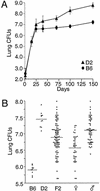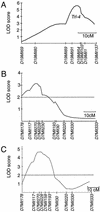Susceptibility to tuberculosis: a locus on mouse chromosome 19 (Trl-4) regulates Mycobacterium tuberculosis replication in the lungs
- PMID: 12740444
- PMCID: PMC164495
- DOI: 10.1073/pnas.1031727100
Susceptibility to tuberculosis: a locus on mouse chromosome 19 (Trl-4) regulates Mycobacterium tuberculosis replication in the lungs
Abstract
The mouse DBA/2 (D2) strain is very susceptible to infection with virulent Mycobacterium tuberculosis, whereas C57BL/6 (B6) is much more resistant. Infection of D2 and B6 mice with M. tuberculosis H37Rv by the respiratory route is biphasic: during the first 3 weeks, there is rapid bacterial growth in the lung of both strains, whereas beyond this point replication stops in B6 but continues in D2, causing rapidly fatal pulmonary disease. To identify the genes regulating growth of M. tuberculosis in the lungs of these two strains, 98 informative (B6 x D2) F2 mice were infected by the respiratory route with M. tuberculosis H37Rv (2 x 102 colony-forming units), and the extent of bacterial replication in the lungs at 90 days was used as a quantitative measure of susceptibility in a whole-genome scan. Quantitative trait locus mapping identified a major locus on chromosome 19 (Tuberculosis resistance locus-4, Trl-4; logarithm of odds 5.6), which regulated pulmonary replication of M. tuberculosis and accounted for 25% of the phenotypic variance. B6 alleles at Trl-4 were inherited in an incompletely dominant fashion and associated with reduced bacterial replication. An additional effect of a locus (Trl-3), previously shown to affect survival to i.v. infection with M. tuberculosis, was also noted. F2 mice homozygous for B6 alleles at both Trl-3 and Trl-4 were as resistant as B6 parents, whereas mice homozygous for D2 alleles were as susceptible as D2 parents. These results suggest a strong genetic interaction between Trl-3 and Trl-4 in regulating pulmonary replication of M. tuberculosis.
Figures



Similar articles
-
Genetic control of susceptibility to infection with Mycobacterium tuberculosis in mice.Genes Immun. 2000 Dec;1(8):467-77. doi: 10.1038/sj.gene.6363712. Genes Immun. 2000. PMID: 11197687
-
Genetic and functional characterization of the mouse Trl3 locus in defense against tuberculosis.J Immunol. 2009 Mar 15;182(6):3757-67. doi: 10.4049/jimmunol.0802094. J Immunol. 2009. PMID: 19265154 Free PMC article.
-
Evidence inconsistent with a role for the Bcg gene (Nramp1) in resistance of mice to infection with virulent Mycobacterium tuberculosis.J Exp Med. 1996 Mar 1;183(3):1045-51. doi: 10.1084/jem.183.3.1045. J Exp Med. 1996. PMID: 8642246 Free PMC article.
-
Susceptibility to Mycobacterium tuberculosis: lessons from inbred strains of mice.Tuberculosis (Edinb). 2003;83(5):279-85. doi: 10.1016/s1472-9792(03)00017-9. Tuberculosis (Edinb). 2003. PMID: 12972341 Review.
-
Genetic dissection of host resistance to Mycobacterium tuberculosis: the sst1 locus and the Ipr1 gene.Curr Top Microbiol Immunol. 2008;321:123-48. doi: 10.1007/978-3-540-75203-5_6. Curr Top Microbiol Immunol. 2008. PMID: 18727490 Review.
Cited by
-
Analysis of cellular phenotypes that mediate genetic resistance to tuberculosis using a radiation bone marrow chimera approach.Infect Immun. 2005 Sep;73(9):6174-8. doi: 10.1128/IAI.73.9.6174-6178.2005. Infect Immun. 2005. PMID: 16113343 Free PMC article.
-
Genetically determined susceptibility to tuberculosis in mice causally involves accelerated and enhanced recruitment of granulocytes.Infect Immun. 2006 Jul;74(7):4295-309. doi: 10.1128/IAI.00057-06. Infect Immun. 2006. PMID: 16790804 Free PMC article.
-
Disseminated and rapidly fatal tuberculosis in mice bearing a defective allele at IFN regulatory factor 8.J Immunol. 2009 Mar 1;182(5):3008-15. doi: 10.4049/jimmunol.0800680. J Immunol. 2009. PMID: 19234196 Free PMC article.
-
Model systems to study Mycobacterium tuberculosis infections: an overview of scientific potential and impediments.Front Cell Infect Microbiol. 2025 May 8;15:1572547. doi: 10.3389/fcimb.2025.1572547. eCollection 2025. Front Cell Infect Microbiol. 2025. PMID: 40406522 Free PMC article. Review.
-
Man and mouse TB: contradictions and solutions.Tuberculosis (Edinb). 2009 May;89(3):195-8. doi: 10.1016/j.tube.2009.02.002. Epub 2009 Apr 2. Tuberculosis (Edinb). 2009. PMID: 19345146 Free PMC article. No abstract available.
References
-
- Dye, C., Scheele, S., Dolin, P., Pathania, V. & Raviglione, M. C. (1999) J. Am. Med. Assoc. 282, 677–868. - PubMed
-
- Young, D. B. & Duncan, K. (1995) Annu. Rev. Microbiol. 49, 47–55. - PubMed
-
- Lienhardt, C. (2001) Epidemiol. Rev. 23, 288–301. - PubMed
-
- Casanova, J.-L. & Abel, L. (2002) Annu. Rev. Immunol. 20, 581–620. - PubMed
-
- Hinman, A. R., Judd, J. M., Kolnick, J. P. & Daitch, P. B. (1976) Am. J. Epidemiol. 103, 486–497. - PubMed
Publication types
MeSH terms
Grants and funding
LinkOut - more resources
Full Text Sources
Molecular Biology Databases
Miscellaneous

